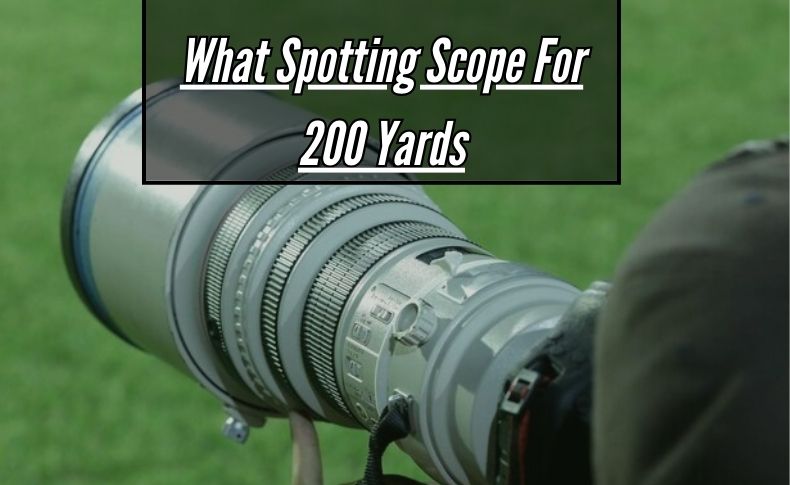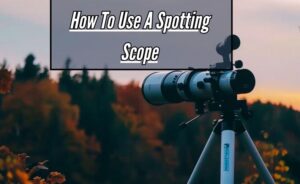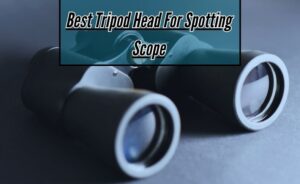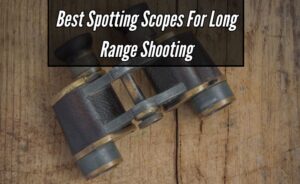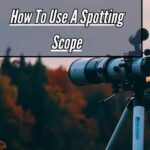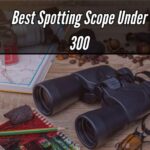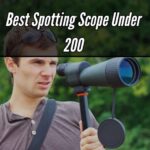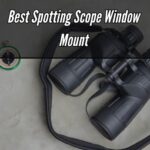Searching for the ideal spotting scope to hit targets at 200 yards? You’re in the appropriate location! Your shooting experience can be greatly enhanced by selecting the appropriate spotting sight. Having the proper gear is crucial whether you’re a hunter, target shooter, or just like spending time at the range.
What Spotting Scope For 200 Yards? Select a spotting scope with good lens quality and a high magnification (between 20 and 60x) for crisp vision at 200 yards. To improve accuracy, look for features like picture stabilization and customizable focus. For outdoor use, weather resistance and durability are also essential.
In this guide, we’ll explore the features you should look for in a spotting scope that’s ideal for 200-yard shots. From magnification power to lens quality, we’ll cover everything you need to know to make an informed decision. So, let’s dive in and find the spotting scope that will help you hit your mark every time!
Understanding the Importance of Spotting Scopes for 200 Yards
Spotting scopes are essential for many outdoor activities, but they are particularly important for shooting sports. The importance of spotting scopes is further demonstrated when it comes to striking targets precisely at a distance of 200 yards. So let’s explore why these optical tools are essential for this particular range.
Understanding Optics for Precision:
At 200 yards, accuracy requires a clear, comprehensive view of the target area. With their superior optics, spotting scopes offer the magnification and clarity required to distinguish important features like target placement, bullet impacts, and wind direction.
Shooters may make well-informed modifications with this level of optical precision, which greatly improves accuracy.
Spotting Scope vs. Binoculars:
While binoculars are useful for a variety of outdoor activities, spotting scopes have clear advantages, particularly when used at longer ranges (such as 200 yards).
When compared to binoculars, spotting scopes usually offer higher magnification levels and larger objective lenses, which produce better image quality and detail resolution. They are therefore more appropriate for accurate target observation and analysis.
Target Identification and Correction:
Accurate target identification and shot placement assessment are essential for success at 200 yards. Shooters can zoom in on targets with a spotting scope, which makes it simpler to discern between various objects and evaluate how well they match with the reticle.
Furthermore, shooters may see bullet impacts on targets with spotting scopes, which allows for quick and efficient changes to increase accuracy.
Enhancing Shooting Performance:
Spotting scopes not only aid in target identification and correction but also contribute to overall shooting performance.
By providing shooters with detailed visibility and analysis capabilities, spotting scopes empower them to make informed decisions and adjustments, ultimately leading to improved accuracy and consistency at 200 yards.
Key Features to Look for in a Spotting Scope for 200 Yards
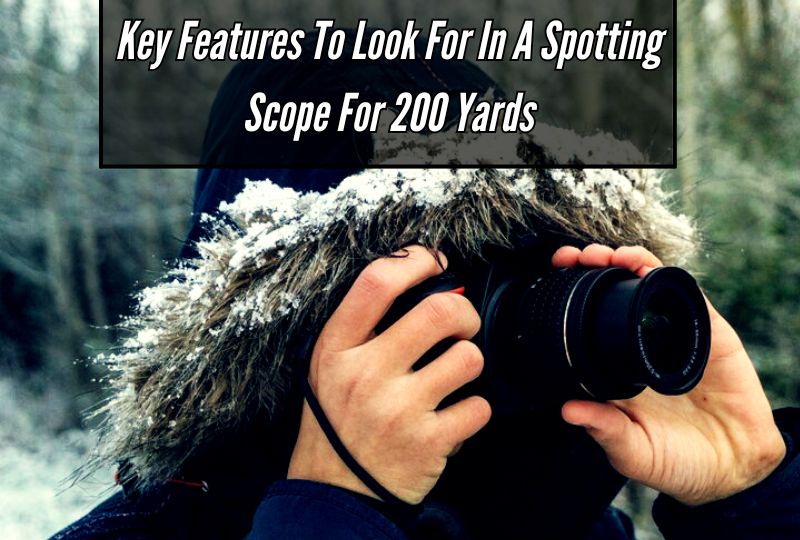
To achieve optimum performance and accuracy, you should consider many important elements when choosing a spotting scope designed for distances of approximately 200 yards.
These are elements that can make all the difference in your spotting experience, be it target shooting, birdwatching, or hunting.
Tailored Optics for 200 Yards:
Optics made specifically for 200 yards or beyond should be given top priority when selecting a spotting scope. Seek out scopes that have been designed with quality optics that are enhanced for clarity and detail at this range.
For 200-yard viewing, features like specially designed lens combinations and coatings provide the best possible performance and image quality.
Appropriate Magnification and Objective Lens Size
Selecting the appropriate magnification level and objective lens size is crucial for an effective spotting scope. For a range of 200 yards, a spotting scope with a magnification range of around 15x to 30x should suffice.
Going for higher magnifications might result in image instability due to atmospheric conditions and hand tremors. Additionally, a larger objective lens (around 60mm to 80mm) gathers more light, enhancing the brightness and clarity of the image, especially in low-light conditions.
Intuitive Focusing Mechanism:
To change your perspective quickly and precisely, you need a focusing mechanism that is responsive and easy to use. Try to find scopes with cutting-edge focusing mechanisms that provide accurate and seamless adjustments so you can swiftly and easily zero in on your target.
Enhanced Light Transmission Technology:
When it comes to low light, choose spotting scopes with sophisticated light transmission technology to get the most brightness and clarity. Light transmission is optimized by features like prism designs and proprietary lens coatings, which guarantee vivid and clear images even whether observing at dawn or dark.
Ergonomic Design for Comfortable Viewing:
Choose a spotting scope with an ergonomic design to put comfort first during long viewing sessions. To reduce fatigue and improve overall viewing comfort, especially during extended usage, look for scopes with user-friendly features like adjustable eyecups, cozy eyepiece designs, and lightweight construction.
Versatile Mounting Options:
When selecting a spotting scope, take into account its mounting adaptability as it can greatly affect how well you view in general. A broad variety of mounting options, such as window mounts, tripod adapters, and vehicle mounts, should be supported by the scope you choose.
This adaptability ensures maximum flexibility and simplicity by enabling you to modify your setup to fit different viewing circumstances and environments.
Lens Quality and Coating: Enhancing Clarity for 200-Yard Viewing
The quality of lenses and the efficacy of their coatings are critical factors in obtaining the best clarity possible for seeing at 200 yards. This is an explanation of how coating and lens quality can greatly improve your viewing experience.
Understanding Lens Quality: The Foundation of Clear Vision
The foundation of any optical device is the quality of its lenses. Precision craftsmanship ensures low distortion and maximum light transmission in high-quality lenses. Better contrast and crisper images are the outcome, which is essential for clear viewing at 200 yards.
Factors Influencing Lens Quality
Lens quality is influenced by a number of elements, including as the production method, curvature, and materials utilized.
Superior optical qualities are provided by premium materials like premium glass or specialty polymers, and each lens is manufactured with precision and consistency thanks to cutting-edge production processes.
Impact of Lens Coating: Minimizing Glare and Enhancing Contrast
When it comes to maximizing light transmission and minimizing reflections, lens coatings are essential. Anti-reflective coatings reduce glare from stray light, making images sharper and more colorful.
They are frequently applied to lens surfaces. Coatings can also improve contrast, which makes items shine out against different backdrops.
Types of Lens Coatings
Many coating varieties exist, each intended to fulfill a particular function. Reduce glare with anti-reflective (AR) coatings; keep the lenses clear and clean even in difficult situations with hydrophobic (HP) coatings, which ward off water and oil.
Furthermore, long-term preservation of the lenses’ optical integrity is ensured by scratch-resistant coatings.
Balancing Coating Effectiveness with Durability
Optical performance can be improved by coatings, but durability and efficacy must be balanced. In addition to enhancing optical clarity, a strong coating should be resistant to extreme temperatures and wear and tear.
To strike this delicate balance between long-term durability and maintaining optical quality, manufacturers use sophisticated coating methods.
The Role of Lens Quality and Coating in Different Environments
Your viewing experience can be greatly impacted by the quality of lenses and coatings, whether you’re watching wildlife, playing sports, or taking in beautiful scenery.
Premium lenses with cutting-edge coatings perform well in a variety of lighting circumstances, from direct sunshine to dimly lit areas, providing crisp, detailed images that let you completely engage with your surroundings.
Durability and Build: Spotting Scopes That Withstand 200-Yard Conditions
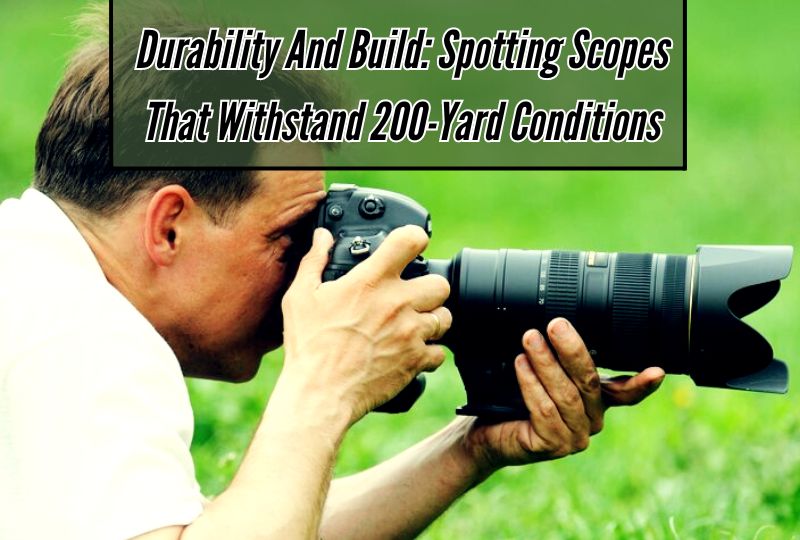
When venturing into the realm of spotting scopes for 200-yard conditions, durability and build quality are paramount considerations.
A reliable spotting scope not only enhances your viewing experience but also withstands the rigors of outdoor use. Here’s a comprehensive guide to help you spot the right one:
Robust Construction:
The foundation of a reliable spotting scope lies in its construction. Opt for scopes built with sturdy materials like magnesium alloy or high-grade polycarbonate.
These materials offer excellent durability without adding unnecessary weight, ensuring your scope can handle the demands of field use without compromising on performance.
Weatherproof Design:
Nature can be unpredictable, so it’s essential to choose a spotting scope with a weatherproof design. Look for scopes that are nitrogen-purged and O-ring sealed, providing reliable protection against moisture, dust, and debris.
This feature ensures uninterrupted viewing even in challenging weather conditions, allowing you to focus solely on your target.
Shock Resistance:
Outdoor adventures often entail rough terrain and occasional bumps. A spotting scope with shock-resistant features can withstand accidental drops and impacts, safeguarding its internal components and optical integrity.
Seek scopes equipped with rubber armor or impact-resistant housing for added protection against knocks and bumps.
Optical Quality:
While durability is crucial, optical performance is equally important. Invest in spotting scopes with premium quality glass and multi-coated optics to ensure crisp, clear images with minimal distortion and glare.
Superior optics enhance your viewing experience, enabling you to discern fine details and track targets with precision, even at extended distances.
Reinforced Mounting Mechanism:
A stable and reliable mounting mechanism is essential for steady viewing, especially when observing distant targets. Look for spotting scopes with reinforced mounting brackets or integrated tripod adapters that securely attach to standard tripod heads.
This feature minimizes vibrations and movement, allowing for steady and comfortable viewing over extended periods.
Field Testimonials and Reviews:
Before making a purchase, it’s beneficial to gather insights from real-world users and experts. Explore field testimonials and reviews from seasoned outdoor enthusiasts and professional marksmen who have tested the scopes under various conditions.
Their firsthand experiences can provide valuable insights into durability, performance, and overall satisfaction with the product.
Warranty and Customer Support:
Lastly, consider the warranty coverage and customer support offered by the manufacturer. A generous warranty reflects the manufacturer’s confidence in their product’s durability and reliability.
Additionally, responsive customer support ensures timely assistance in case of any issues or concerns, giving you peace of mind throughout your outdoor pursuits.
Expert Insights: Matching Spotting Scope Accessories to 200-Yard Shooting
Crafting Your Optics Arsenal: A Guide to Tailored Accessories
Embarking on your journey toward 200-yard shooting proficiency involves assembling a toolkit of precision accessories tailored to your spotting scope. Each piece plays a vital role in enhancing your shooting experience, from eyepieces to tripods, and beyond.
Fine-Tuning Visual Acuity: Exploring Advanced Optical Enhancements
Achieving optimal clarity and precision at 200 yards requires more than just a standard spotting scope. Dive into the world of advanced optical enhancements, where specialized lens coatings and innovative technologies elevate your viewing experience to new heights.
Stability and Beyond: Unveiling the Secrets of Rock-Solid Support Systems
Stability is the cornerstone of accurate shooting, especially at longer distances. Discover the intricacies of high-quality tripods and mounting systems designed to provide rock-solid support, ensuring steady aim and minimal disturbance during critical shots.
Portability Perfected: Solutions for Shooting on the Move
Shooting at 200 yards demands versatility, and portability is key to adapting to varying conditions and environments. Explore lightweight and compact accessory options that allow for easy transport without compromising performance or functionality.
Accessorizing for Success: Maximizing Performance with Additional Gear
Beyond the essentials lies a world of supplemental accessories that can fine-tune your shooting setup for peak performance. From lens filters to carrying cases, each addition serves a specific purpose in optimizing your shooting experience at 200 yards and beyond.
Beyond the Horizon: Optimal Spotting Scopes for 200 Yards and Beyond
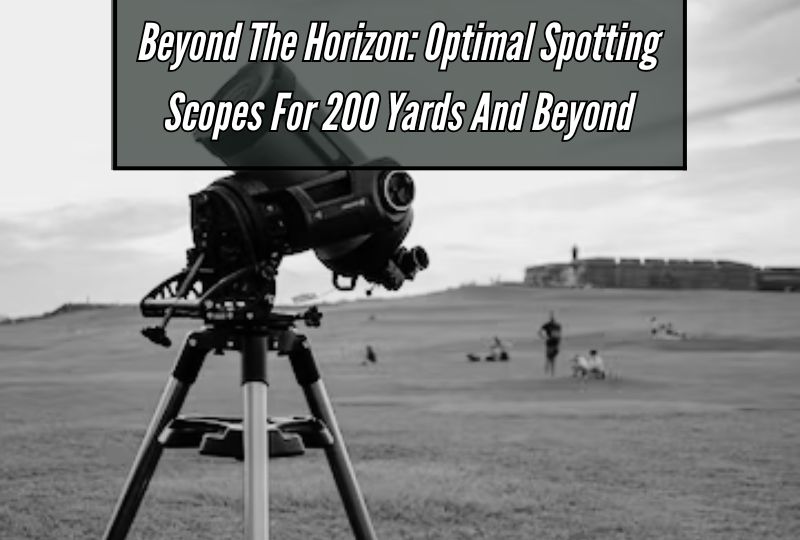
With spotting scopes made to reach farther than the horizon, set off on an adventure beyond the norm. Here, we present cutting-edge optics designed to revolutionize long-range observation, providing unmatched accuracy and clarity out to 200 yards.
Mastering Precision Engineering: Focus Mechanisms and Control Dynamics
With carefully designed focus mechanisms and user-friendly control dynamics, you may realize the full potential of long-range observation. Users may easily capture little details and ensure maximum clarity and precision over long distances by becoming skilled at fine-tuning focus and zoom settings.
Navigating the Elements: Weatherproof Design and Environmental Adaptability
Spot scopes designed for durability can help you navigate across difficult terrain and erratic weather. These scopes are designed to withstand harsh weather conditions and environmental changes.
With their unwavering performance and dependability, they provide users the confidence to take on any terrain.
Unveiling the Artistry of Optical Design: Compact Form Factors and Performance Enhancement
Experience the convergence of art and technology with spotting scopes that blend compact form factors with unparalleled performance enhancement.
Through innovative optical design, these scopes deliver exceptional image quality and versatility, transcending the boundaries of traditional long-range optics.
Integrating Stability Solutions: Versatile Mounting Options for Precision Viewing
Improve the quality of your viewing experience with adaptable mounting options that offer accuracy and stability in every setting.
Whether using window mounts, tripods, or specialized systems, a smooth integration improves stability and increases the number of applications for spotting scopes that can be used beyond 200 yards.
Pushing the Boundaries of Innovation: Advanced Features for Enhanced Functionality
Spotting scopes are outfitted with cutting-edge technologies that enhance functionality and user experience, pushing the boundaries of innovation.
These features, which accommodate a variety of uses and preferences, including smartphone compatibility, reticle settings, and image stabilization, enable users to venture into previously uncharted territory in long-range observation.
Conclusion
In conclusion, improving your shooting or observation skills requires selecting the best 200-yard spotting scope available. You may make an informed choice by taking into account aspects like durability, lens quality, and magnification. When prioritizing characteristics, keep in mind that whether you’re hunting, target shooting, or observing animals, your needs should come first.
You may improve your whole outdoor experience by having crisp, accurate views out to 200 yards with the correct spotting scope. So make an informed decision and confidently go out on your next trip!
Frequently Asked Questions (What Spotting Scope For 200 Yards)
What magnification is suitable for spotting scopes at 200 yards?
A magnification range of 15x to 20x is typically appropriate for viewing targets at 200 yards with clarity and detail. Without giving up too much of your field of view, you can zoom in close enough to see your target well at this range. Owing to air conditions or vibration, higher magnifications may make it more difficult to maintain a steady image.
Taking into account the brightness of the image at greater amplifications and the quality of the optics is also crucial. You can discover the ideal ratio of zoom to clarity for your particular requirements by experimenting with various magnification levels.
Is a straight or angled spotting scope better for 200-yard range shooting?
Comfort and personal taste will determine whether you use a straight or an angled spotting scope for shooting at 200 yards. Simpler to operate, straight scopes provide for faster target identification because the objective lens and eyepiece are positioned in a straight line.
But when using an angled scope, especially when sharing it with people of different heights, the eyepiece is positioned at an angle, making it more comfortable for prolonged viewing periods. Also, they enable for easier positioning adjustments when shooting at various angles or heights because they provide greater flexibility. To find out which is most comfortable and practical for your shooting requirements, it’s best to try both sorts.
Which objective lens size is optimal for 200-yard spotting scopes?
An objective lens size of between 60mm and 80mm works best for 200-yard spotting scopes. A decent compromise between portability and light-gathering capacity is offered by this size range. More light is captured by an objective lens with a larger size, producing images that are crisper and brighter—especially in low light.
Larger lenses do add bulk and weight to the scope, though, which may make it less portable. Smaller objective lenses, on the other hand, may compromise on brightness and image quality but are lighter and more portable. To achieve a fair balance between performance and practicality while seeing targets at 200 yards, it is therefore recommended to select an objective lens size between 60mm and 80mm.
Are ED glass lenses essential for 200-yard spotting scopes?
Extra-low Dispersion, or ED, glass lenses are optional but can significantly improve spotting scope performance while viewing objects at 200 yards. Images using ED glass are crisper and more color-accurate because it reduces chromatic aberration, especially at higher magnifications. Your viewing experience will be enhanced overall as a result of being able to perceive finer details and less color fringing around things.
Spotting scopes without ED glass can still function satisfactorily, though, especially if they make use of high-quality construction and other cutting-edge optical coatings. A spotting telescope with ED glass lenses can make for a more enjoyable viewing experience if image clarity is important to you and you can afford it, but it’s not a must for seeing objects at 200 yards.
What weatherproofing features are crucial for 200-yard spotting scopes?
For 200-yard spotting scopes to be durable and function well under a variety of circumstances, weatherproofing characteristics are essential. Waterproofing is one of the main requirements to prevent moisture damage, especially in humid or rainy settings. The process of fog-proofing, which is usually accomplished by purging with argon or nitrogen, stops interior fogging brought on by temperature variations.
Furthermore, sturdy building materials that are perfect for outdoor use, like rubber armor, offer impact resistance and a firm grip. Additional defense against the entry of dust and debris is provided by sealed joints and O-ring seals. All of these weatherproofing elements work together to guarantee that your spotting telescope stays dependable and operational—even in inclement weather—so you can confidently keep clear views of targets up to 200 yards away.
Should eye relief be a significant consideration for a 200-yard spotting scope?
Yes, when choosing a 200-yard spotting scope, eye relief is an important factor. The distance that keeps your whole field of vision intact between the eyepiece and your eye is referred to as eye relief. Extended eye relief is essential, particularly when using the scope for extended periods of time or if you wear spectacles.
You can watch comfortably without straining your eyes or needing to push your glasses up against the eyepiece. Longer eye relief can also improve safety by lessening the chance of gun recoil-related injuries. As a result, be sure the spotting scope you use for 200-yard shooting has enough eye relief to provide a secure and pleasant viewing experience.

